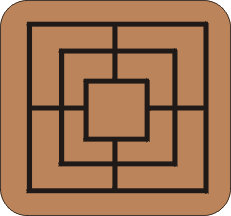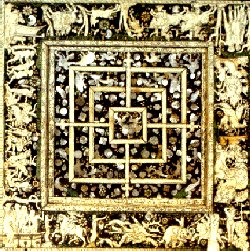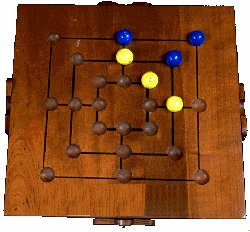
Archaeological evidence has been found in ancient Egypt, Israel, Troy, Ireland, Norway - even on a 1000 year old Viking burial ship - to name just a few places in the world where this game was played. It has been speculated that perhaps Greek or Phoenician traders introduced the game to Northern Europe, while others indicate that Arabic people from North Africa may have introduced the game into southern Europe.
The game has many related names in different languages - Mill or Morris games in English, Mérelles in French, Morels in Spanish, Mühle in German, Mølle in Norwegian for example. Some scholars indicated that the name of the game may have come from an Old French word "merel" - the word for coin or counter (marker). The word "morris" is thought to be a slur of the original French word. A second theory is that the name may be a corruption of the word "Moor" - the name of the Arabic people from North Africa who may have introduced the game into southern Europe.
 |
 |
The above two graphics are details about Mill games from pages in the 13th century The Book of Games, produced under the direction of Alfonso X (1221-1284), King of Castile (Spain). He commissioned the first encyclopedia of games in European literature. Alfonso was a brilliant scholar and was known as El Sabio (The Learned). He personally supervised a group of Jewish, Moorish, and Christian artists and writers whose task it was to produce a series of books on all of the most important topics of his time - history, law, religion, astronomy, and games!
Since the book was produced before the invention of the printing press, each page in The Book of Games is hand painted and lettered. While the text on each page presented commentary on the game, the artists who produced the illustrations used an interesting technique to explain each game. Players are always shown in profile, while the game boards are viewed from overhead! Note that the two young men (with the observers) in the top picture are playing the game using dice. At sometime in the ensuing years, the game changed somewhat and dice were eliminated from the game, and players relied completely on strategy.

The photograph on the right is a photographic reproduction of an elaborate 16th century German Mühle board The actual board is housed in the Bavarian National Museum in Munich, and was probably made for an upper-class Bavarian family and was made in southern Germany sometime between 1560 and 1580. The photographic reproduction illustrates the original board which is 35.5cm square, and hand crafted of pear wood, horn, bone, ivory, brass, and mother-of-pearl. The playing surface of the board is in the center- four concentric squares and the intersecting lines. The playing surface is set in the middle of a large frame. The frame is decorated with scenes of hunting and warfare. The scenes are made of inlays of the various substances - horn, bone, ivory, mother-of pearl, etc.

The photograph of the board on the left is of a mill game that was donated in 1981. The donor, who owned a general store in Northern Ontario, found the board among the original sales stock. The board was manufactured by Somerville Industries Limited, Canada, and has the Serial Number S-530. It is estimated that the board was manufactured in the 1930s. The board is 36cm square and 2.2cm thick. The brown wood frame is joined by metal flanges at the corners. The playing surface is made of printed paper over cardboard, with holes punched out for the markers. The back of the board is covered with a red textured paper. The picture in the center of the board is of a "Mill". Along with the board is a small (6.5cm long x 12.3cm wide x 2.3cm high) covered box. In the box are the game markers - 9 red wooden balls and 9 black wooden balls. Each ball is 1.8cm in diameter. The box top features black print in English indicating that it contains the playing pieces for the game. Manufacturing information is also printed on the box.

Available from Berea College Student Craft Industries(Kentucky, US) in 1972, this wooden board features the traditional layout for the game of Nine Men's Morris. A unique feature of the board is that it is a solid piece of wood, but holes have been drilled into the four sides for use as storage bins for marble counters. Covering each of the holes is an hourglass shaped piece of wood attached by a nail in the middle of the shape - thus enabling the hourglass to be rotated to remove or re-store the counters.
Play takes place on the 24 points where the lines meet. Each of two players take turns placing a counter on any empty point. When all 18 counters have been used, players take turns moving one counter at each turn to the next empty point along a line. Jumping is not permitted. Each player tries to make a row of three counters of the same color along any straight line. This is called a "mill". A player who makes a mill then can remove one of the opponent's counters from the board - if it is not part of an opponent's "mill". When there are no longer any counters on the board that are not part of a "mill", a player may then take a counter from an opponent's "mill". Counters taken from the board cannot be used again in that game. The loser is one who only has two counters on the board or is blocked from moving.
Last update March 30, 2010